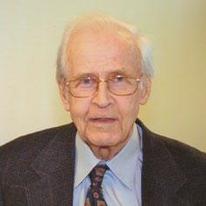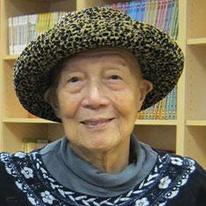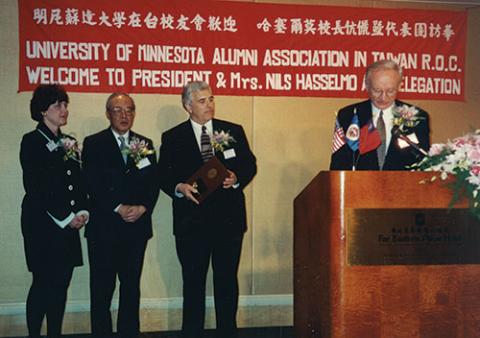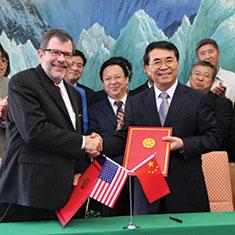The work of University of Minnesota faculty, staff, and leadership is essential in maintaining and strengthening ties between the University and China. Many faculty and staff have led the way in addressing some of the world’s most pressing problems, advocating for Chinese studies on campus, and encouraging the exchange of U.S. and Chinese students.
Early Pioneers

University professor Harold S. Quigley, form the department of political science, was one of the pioneers in developing University-China collaborations. He taught at China’s Tsinghua College from 1921 to 1923. Upon his return to the University, professor Quigley taught the course “Far Eastern Government and Politics,” which was considered the first such course to be offered in the U.S.
In 1973, University Professor Robert Poor, a well-known Bronze Age archaeologist, traveled to China and gave two lectures as part of a U.S. delegation to China. It was the second U.S. delegation to China, following President Richard Nixon’s first U.S. delegation to China in 1972. Also in 1973, the Chinese government invited University Professor Chih-Chun Hsiao to give a lecture in China. He had the distinction of being one of the first U.S.-based, China-born scientists to receive such an invitation.
University Professor Jack C. Merwin, from the College of Education and Human Development, joined the first delegation of professional educators to China in 1974. The following year, University Professor Huai C. Chiang, who is credited for the extensive agricultural research partnership between the University and China, was invited by the U.S. National Academy of Sciences to visit China. Then in 1979 he hosted one of the first visiting scholars from Mainland China to Minnesota since 1949.
Also in 1979, University Medical School Professor Paul Quie and Professor Philip Peterson hosted visiting scholar Dr. Wu Xi-Ru, a research fellow in pediatric neurology. Dr. Wu went on to become a famous Chinese pediatric neurologist and has been facilitating bilateral research exchanges with the University since then.
Chinese Studies Established

In 1949, University Professor Richard Mather established the Chinese language and literature program at the University of Minnesota. For nearly four decades, Professor Mather served as the major force for Chinese studies at the University. He was highly respected in the field of early medieval Chinese studies because of his monumental translation work on the topic.
Legendary Leadership

University Professor Chun-Jo Liu, who taught East Asian languages, spent her life building bridges between the University and China. She helped the University become one of the first U.S. universities to reach out to China in 1979. She also led trips for University professors and students, set up exchange programs, and worked to improve curriculum in the U.S. and China.
Exchanges Resume
Regent Wenda Moore headed the first University of Minnesota delegation to China in 1979. The delegation was received by Chinese Vice Prime Minister Yi Fang at the Great Hall of the People and signed agreements with Jilin University of Technology, Nankai University, National Academies of Agricultural Sciences and Agricultural Engineering, and Beijing Agriculture University.

University Presidential Delegations
Five University of Minnesota presidents have led a total of six presidential delegations to the Greater China area. Each delegation sought to strengthen ties with universities, alumni, and the business community.
President C. Peter Magrath led the first University presidential delegation to China in 1981. The delegation visited the Chinese Academy of Sciences and the Chinese Academy of Social Sciences, and met with more than 100 alumni from various parts of China.
Fourteen years later, President Nils Hasselmo led two University presidential delegations to China in 1995 and 1996. The visits represented a strong effort by the University to reconnect and develop ties with Chinese alumni and friends.


agreement with the Chinese
Academy of Sciences in 2013
In 2000, President Mark Yudof led a University presidential delegation to the greater China area, where he visited Hong Kong, Guangzhou, Xi’an, Beijing, Guilin, and Taipei. The delegation had the honor to meet with Chinese Prime Minister Li Lanqing.
President Robert Bruininks led a University presidential delegation to China in 2004. The delegation visited Taiwan, Hong Kong, Guangzhou, Shanghai, Chengdu, and Beijing.
In 2013, President Eric Kaler led a University presidential delegation to Hong Kong, Shanghai, Beijing, Tianjin, and Taipei. He renewed agreements with the Chinese Academy of Sciences; Peking University; Tsinghua University; Tianjin University of Sport; Shanghai Jiaotong University; Hong Kong University of Science and Technology; National Taiwan University; and the Confucius Institute Headquarters.
This information was compiled in 2014 for China 100, a yearlong celebration honoring the first students from China and the wealth of connections that have come since.
